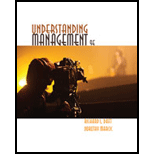
Case summary/Introduction:
Social media and electronic communication in general is the main way for people to communicate with each other. However, T.C feels it's more significant and meaningful to make a connection with somebody. T's traditional communication methods seem out of touch with twenty-first century communication technologies. However, the communication required within Plant Fantasies have to be peaking directly with designers and so on, and therefore electronic communication is not ideal. According to S.M nothing beats a personal meeting with clients.
Characters in the case:
T.C, S.M.
Adequate information:
Even though face-to-face communication is preferred in the organization, electronic communication is also a part of the organization's operations, mainly communicating with employees who are on the go and such.
To determine:
The reasons for placing high value on face to face communication.
Want to see the full answer?
Check out a sample textbook solution
Chapter 13 Solutions
Understanding Management
- Strategy Formation Experiences Please share an experience in which you played the strategist. What was intended to be achieved? Did the guiding strategy form deliberately, did the guiding strategy emerge or did both elements–deliberate and emergent strategy come into play? Reflecting on your experience, how could the strategy formation process you used be improved?arrow_forwardDiscuss the importance of Ethical leadership from the perspective of King IV and Virtue Ethicsarrow_forwardGeneral accountingarrow_forward
- The St. Louis Cardinals would like to improve their post season performance this year. They have hired you as a consultant to study the team during winter practice and help their analytics team to fine tune their on-field performance. Armed with your recent knowledge of sampling and estimation, you set to collect data and provide feedback to the team. How can you help the team from what you have learned in this chapter? Describe your sampling plan? What data would you like to collect, the parameter(s) of interest. How you would use the confidence interval to inform the team?arrow_forwardHi! Can you guys help me with this? Thank you! Here's the article by Lingling Wei from Wall Street Journal called U.S. News --- THE OUTLOOK: Chine Weighs Export Cut to Blunt Tariffs Please offer authentic insights on how this article connects with global supply chain management.arrow_forwardCan you guys help me on this? Thank you! Here's the authentic insight my classmate wrote about the article they chose here. Please give a little comment on this insight that my classmate just wrote. Thank you!arrow_forward
- Identify potential ethical challenges in producing and marketing your company's skincareproducts in europe and associated countries like germany italy and france and how your team will address them.arrow_forwardDiscuss knowledge and skills international managers need to navigate the expansion of skincare line in international markets such europe including countries like germany italy and francearrow_forwardResearch Methods for Business Research Topic : Improving Customer Retention in the Hotel Industry Through Personalized Marketing Strategies. 1. Based on the research topic please provide an introduction for a research report. Please use the screenshot for guidance on how to do the introduction. please add citations and references.arrow_forward
- Discuss knowledge and skills international managers need to navigate the expansion ofskincare line in international markets such as europe including countries like germany italy and francearrow_forwardYou have reviewed probability rules and the types of probability distributions in this chapter. For this discussion board assignment: Describe ways you are applying (or can apply) probability distributions in your workplace. Choose a discrete probability distribution and a continuous probability distribution, and describe how they can assist you in your profession. If you are not currently working, describe how they can assist in your targeted profession. How can the tools learned in this chapter help you make better decisions at work?arrow_forward| do not copy from another same ques answer,i need differe nt one. Task Description: One of the most important questions faced by business leaders in the strategic marketing process is a choice of timing to launch new product/technologies and enter new markets. There are two options: to be a pioneer or to be a follower. Both have advantages and risks, the relative success of each strategy depends on several factors, both internal and external. Tasks: Answer the following essay questions: 1. What are the advantages of being a pioneer and follower company? Provide examples of successful pioneer and follower companies. 2. What product life cycle strategies do successful pioneer and follower companies implement to increase growth and maintain a strong competitive advantage? Provide examples of companies to support statements made. Follow instruction: 1. Word: within 2500 word, not bellow 2400. 2. Give table, charts, diagrams, graphs and images should be properly cited and properly named.arrow_forward
 Management, Loose-Leaf VersionManagementISBN:9781305969308Author:Richard L. DaftPublisher:South-Western College Pub
Management, Loose-Leaf VersionManagementISBN:9781305969308Author:Richard L. DaftPublisher:South-Western College Pub- MarketingMarketingISBN:9780357033791Author:Pride, William MPublisher:South Western Educational Publishing
 Contemporary MarketingMarketingISBN:9780357033777Author:Louis E. Boone, David L. KurtzPublisher:Cengage Learning
Contemporary MarketingMarketingISBN:9780357033777Author:Louis E. Boone, David L. KurtzPublisher:Cengage Learning Foundations of Business (MindTap Course List)MarketingISBN:9781337386920Author:William M. Pride, Robert J. Hughes, Jack R. KapoorPublisher:Cengage Learning
Foundations of Business (MindTap Course List)MarketingISBN:9781337386920Author:William M. Pride, Robert J. Hughes, Jack R. KapoorPublisher:Cengage Learning





